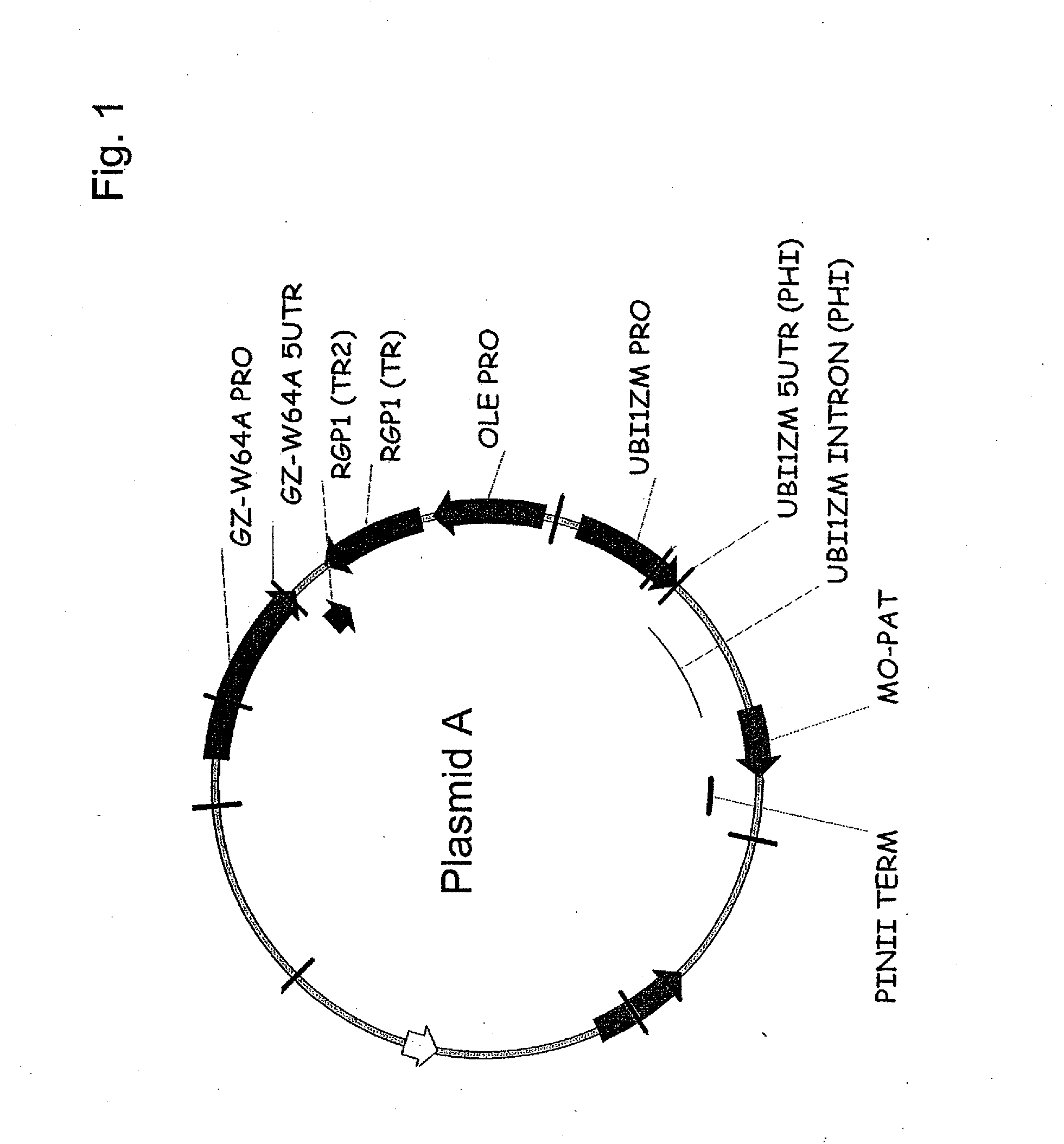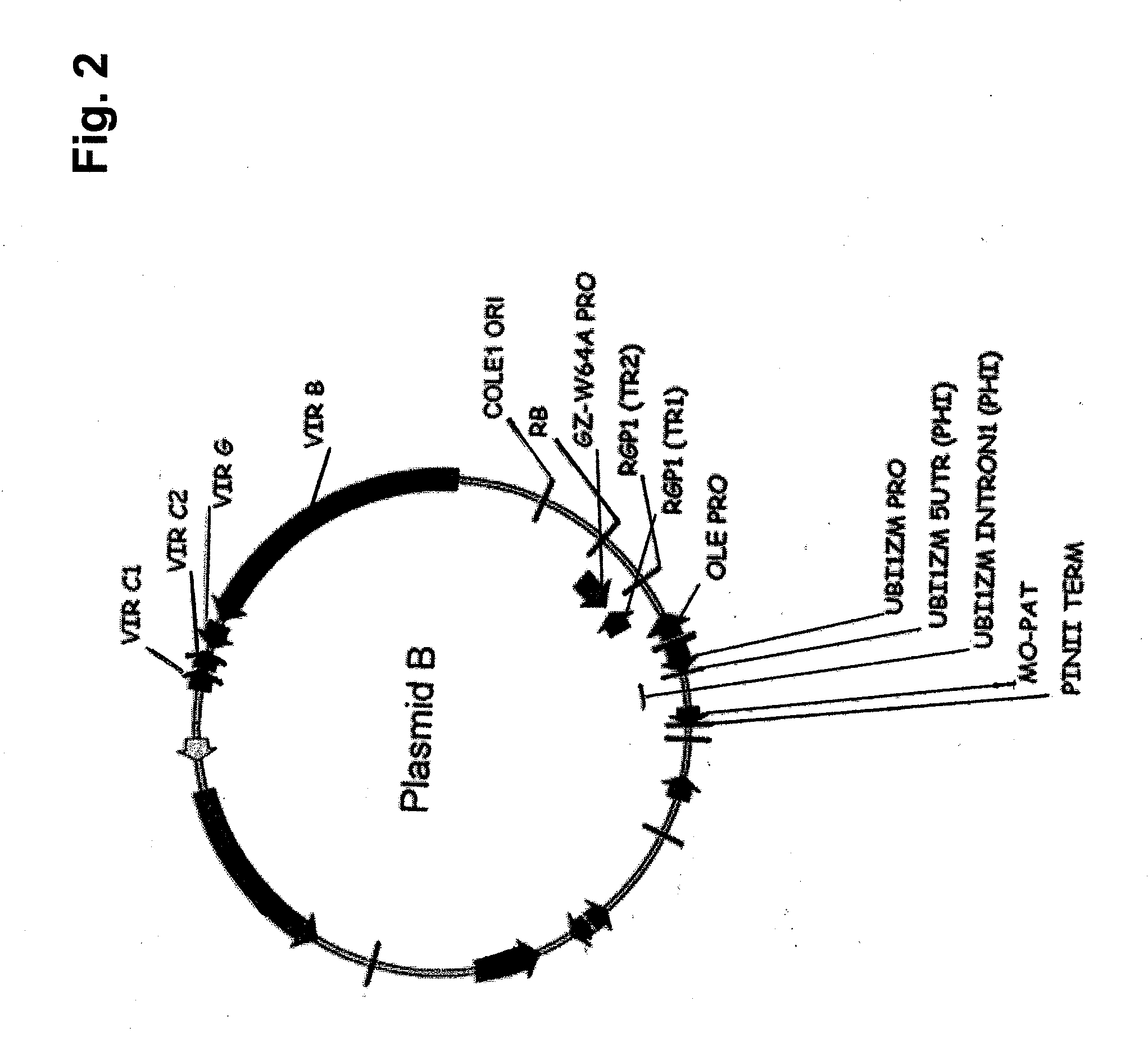Compositions and methods for modulating expression of gene products
a technology of gene products and expression, applied in the field of gene function modulation, can solve the problems of increasing the regulatory burden for sequence and expression confirmation, increasing the risk of undesirable rearrangements and deletions, and occupying valuable space, so as to improve the characteristics of commercially important plants and plant parts, the effect of reducing expression and function
- Summary
- Abstract
- Description
- Claims
- Application Information
AI Technical Summary
Benefits of technology
Problems solved by technology
Method used
Image
Examples
example 1
Suppression Cassette Provides for Differential Promoter Expression of Reversibly Glycosylated Polypeptide-1 (RGP1)
[0149]The maize RGP1 gene encodes a polypeptide that is involved in hemicellulose production (see, for example, U.S. Pat. No. 6,194,638, herein incorporated by reference in its entirety). An inverted repeat comprising a sense and antisense sequence of the maize RGP1 gene was created using standard molecular biology protocols. A 277 base pair (bp) HindIII-ApaI fragment from the 5′ end of the RGP1 coding sequence was ligated into a cloning intermediate. This plasmid was restriction digested, the end filled in with Klenow enzyme, and then digested with a second restriction enzyme. Into this backbone, a second fragment of RGP1 (an 848 by BamHI / HpaI fragment, also from the 5′ end of the coding sequence) was ligated, such that the second fragment was in reverse orientation relative to the first fragment. The suppression cassette was created by moving the promoter from the maiz...
example 2
Maize Transformation
[0157]Immature maize embryos from greenhouse donor plants are bombarded with a plasmid containing the suppression cassette and the selectable marker gene PAT (Wohlleben et al. (1988) Gene 70:25-37), which confers resistance to the herbicide Bialaphos. Alternatively, the selectable marker gene is provided on a separate plasmid. Transformation is performed as follows.
[0158]The ears are husked and surface sterilized in 30% Clorox bleach plus 0.5% Micro detergent for 20 minutes, and rinsed two times with sterile water. The immature embryos are excised and placed embryo axis side down (scutellum side up), 25 embryos per plate, on 560Y medium for 4 hours and then aligned within the 2.5 cm target zone in preparation for bombardment.
[0159]A plasmid vector comprising the suppression cassette described above and the selectable marker gene PAT is made. This plasmid DNA plus plasmid DNA containing a PAT selectable marker is precipitated onto 1.1 μm (average diameter) tungste...
example 3
Agrobacterium-Mediated Transformation
[0165]For Agrobacterium-mediated transformation of maize with the suppression cassette, the method of Zhao is employed (U.S. Pat. No. 5,981,840, and PCT patent publication WO98 / 32326; the contents of which are hereby incorporated by reference). Briefly, immature embryos are isolated from maize and the embryos contacted with a suspension of Agrobacterium, where the bacteria are capable of transferring the suppression cassette of the invention to at least one cell of at least one of the immature embryos (step 1: the infection step). In this step the immature embryos are immersed in an Agrobacterium suspension for the initiation of inoculation. The embryos are co-cultured for a time with the Agrobacterium (step 2: the co-cultivation step). The immature embryos are cultured on solid medium following the infection step. Following this co-cultivation period an optional “resting” step is contemplated. In this resting step, the embryos are incubated in t...
PUM
| Property | Measurement | Unit |
|---|---|---|
| temperature | aaaaa | aaaaa |
| temperature | aaaaa | aaaaa |
| pH | aaaaa | aaaaa |
Abstract
Description
Claims
Application Information
 Login to View More
Login to View More - R&D
- Intellectual Property
- Life Sciences
- Materials
- Tech Scout
- Unparalleled Data Quality
- Higher Quality Content
- 60% Fewer Hallucinations
Browse by: Latest US Patents, China's latest patents, Technical Efficacy Thesaurus, Application Domain, Technology Topic, Popular Technical Reports.
© 2025 PatSnap. All rights reserved.Legal|Privacy policy|Modern Slavery Act Transparency Statement|Sitemap|About US| Contact US: help@patsnap.com



